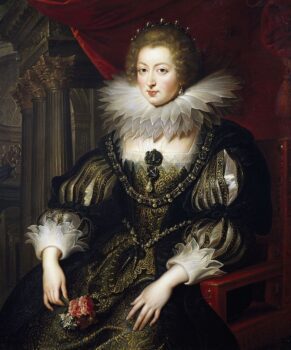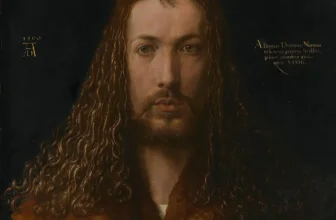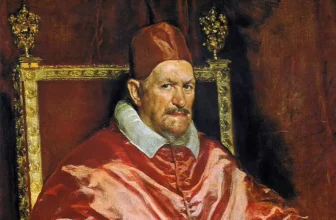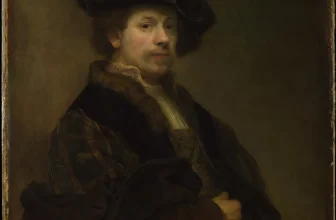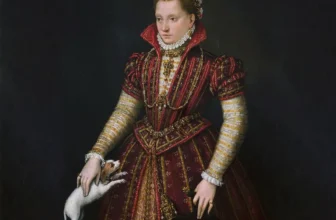What Is the “Portrait of Anne of Austria” Portrait All About?
Peter Paul Rubens, the Flemish master of Baroque painting, remains one of the most influential artists in European art history. Among his many remarkable portraits, the “Portrait of Anne of Austria” stands out as a powerful representation of royal authority, feminine grace, and political symbolism. Painted around 1622–1625, during a time of great political tension and dynastic consolidation in Europe, this portrait is not merely a depiction of a queen, it is a carefully constructed visual statement about power, identity, and legacy.
In this in-depth analysis, we explore who Anne of Austria was, how and why Rubens painted her, what the painting represents, its artistic type, and the symbolic meanings woven throughout the image. We will also touch on its historical and current market value, and where the painting is housed today.
Who Was Anne of Austria?
Anne of Austria (1601–1666) was born into the powerful Habsburg dynasty, the daughter of King Philip III of Spain and Margaret of Austria. Despite her name, she was actually Spanish by birth, and the “Austria” in her title refers to her dynastic affiliation with the Habsburgs. In 1615, she was married to Louis XIII of France as part of a political alliance between the Bourbon and Habsburg families, one of the most significant diplomatic unions of early 17th-century Europe.
As queen consort of France, Anne played a vital role in dynastic politics and served as regent during the minority of her son, Louis XIV, the future Sun King. Her reign was marked by political intrigue, tensions between France and Spain, and the early seeds of French absolutism.
Peter Paul Rubens: The Artist and the Diplomat
Peter Paul Rubens (1577–1640) was not only an artist of remarkable talent but also a diplomat who moved in the highest circles of European power. His art is characterized by dramatic compositions, vigorous brushwork, and a rich, sensual style that embodied the Baroque spirit of grandeur and emotion. Rubens often undertook commissions for powerful European courts, and his portraits served not just aesthetic purposes but also political ones.
Rubens traveled extensively between European courts, and his connections enabled him to paint numerous monarchs and aristocrats. The portrait of Anne of Austria was likely commissioned during one of his diplomatic or artistic visits to the French court, perhaps while Rubens was negotiating on behalf of the Spanish Netherlands.
The Creation of “Portrait of Anne of Austria” Painting
The “Portrait of Anne of Austria” was painted around 1622–1625, likely in France during Rubens’s time at the French court. The work was executed in oil on canvas, a medium in which Rubens excelled. It is part of a series of court portraits Rubens completed for the French royal family, including depictions of Marie de’ Medici, the mother-in-law of Anne of Austria.
Rubens may not have painted the entire portrait himself. As was common practice among master painters of the time, Rubens employed a large workshop of skilled assistants who contributed to the rendering of garments, backgrounds, and details. However, the face and hands, crucial parts of the portrait, were likely painted by Rubens himself. These elements convey the queen’s expression, poise, and character, and they demonstrate Rubens’s consummate skill in capturing both likeness and psychological depth.
At its surface level, the “Portrait of Anne of Austria” is a formal depiction of the queen consort of France. However, it is much more than a mere likeness. This painting functions as visual propaganda, meant to assert Anne’s royal legitimacy, cultural refinement, and political power.
The portrait was created during a time when monarchs used art as a strategic tool for image-building. The representation of Anne as regal, composed, and dignified served to reinforce her authority, particularly as she struggled to gain political influence in the French court and later as a regent for her son.
It was also intended to link Anne of Austria to the long tradition of powerful, virtuous women in European history, thus justifying her prominent role in court and governance.
Symbolism and Deeper Meaning
The symbolism in the “Portrait of Anne of Austria” is rich and multilayered. Every detail of the portrait was carefully chosen to communicate a specific message about the queen’s status, virtues, and political role.
5.1. The Attire
Anne is dressed in luxurious court attire, laden with lace, pearls, and embroidery, symbols of her royal status and wealth. Her clothing is not just decorative; it signals her power and dynastic lineage. Pearls, in particular, symbolized purity and wisdom, suggesting her moral fitness to rule and her spiritual virtue.
5.2. The Color Scheme
Rubens often used color symbolically. In this portrait, dark and rich tones, such as deep crimson, gold, and velvet blacks, create a solemn and majestic atmosphere. These hues lend gravitas to Anne’s figure and elevate her status as a monarch.
5.3. The Hand Gesture
Her hand placement, calmly resting or slightly poised, may indicate authority tempered by grace. Such gestures were often used in royal portraiture to project confidence, divine right, and control over one’s emotions, key traits in an ideal ruler.
5.4. The Background
Though the background in Rubens’s portraits is often relatively subdued to highlight the subject, architectural or textile elements are typically included to denote cultural sophistication and power. A classical column, velvet drapery, or embroidered tapestry often appear behind queens and kings in Baroque portraiture, referencing classical antiquity and Renaissance ideals of nobility.
5.5. Facial Expression
Rubens masterfully captures Anne’s expression: serene, confident, and slightly aloof. Her expression communicates not vulnerability but dignity and restraint, virtues associated with the ideal monarch. It also conveys the Habsburg ideal of majesty through detachment, a queen who remains above the fray of politics but always in control.
Artistic Style and Type of Art
The “Portrait of Anne of Austria” is a quintessential Baroque portrait. The Baroque period, spanning the late 16th to early 18th centuries, was characterized by dynamism, emotional intensity, and grandeur. However, unlike Rubens’s more theatrical mythological or religious scenes, this portrait is relatively restrained, appropriate for its purpose.
Baroque Elements in the Portrait:
Realism and Idealization: Rubens balances a lifelike depiction of Anne with idealized beauty.
Dramatic Lighting: The use of chiaroscuro subtly highlights Anne’s features and emphasizes the volume of her garments.
Monumentality: Even in a portrait, Rubens imparts a sense of scale and importance, giving Anne an almost statuesque presence.
While painted in oil on canvas, Rubens’s technique, swift brushwork, rich glazes, and layered pigments, gives the image depth and luminosity. The softness of the skin tones against the crisp detailing of the fabrics showcases his technical brilliance.
What Is Happening in the Painting?
On the surface, the “Portrait of Anne of Austria” shows the queen standing or seated, facing the viewer. There is no narrative action, no unfolding event, but in a symbolic sense, much is happening. The painting captures a moment of state performance, in which Anne’s entire presence, from her expression to her attire, communicates her right to rule and her embodiment of queenly virtues.
The pose is likely a deliberate echo of other royal portraits, such as those by Titian or earlier Habsburg painters, linking Anne visually to her predecessors and reinforcing the continuity of dynastic power.
Value and Market Worth
As with most paintings by Peter Paul Rubens, the “Portrait of Anne of Austria” would be considered priceless in terms of historical, artistic, and cultural value. While it is rare for such works to appear on the open market, if it ever were to be sold, estimates would likely range into the tens or hundreds of millions of dollars, depending on its condition, provenance, and demand.
Rubens’s paintings have sold for over $70 million USD at auction, and royal portraits carry added historical significance that increases their worth. However, paintings like this are more commonly held in public collections, where they are protected as cultural heritage and not subject to market speculation.
Current Location: Where Is the Painting Today?
The “Portrait of Anne of Austria” by Peter Paul Rubens is currently housed in the Musée du Louvre in Paris, France. The Louvre holds one of the largest and most comprehensive collections of European painting in the world, and Rubens’s work is featured prominently in its Baroque galleries.
This portrait forms part of a larger collection of royal and diplomatic portraiture, allowing visitors to appreciate it in its full historical context. The museum provides insights into how Rubens’s work supported political narratives and how portraiture shaped the identities of early modern monarchs.
“Portrait of Anne of Austria” Legacy
Rubens’s portrait of Anne of Austria endures not only as a remarkable example of Baroque portraiture but also as a document of historical significance. It offers us a glimpse into the world of 17th-century court politics, where power was performed through image as much as policy.
The painting reflects broader themes of the Baroque age, drama, elegance, authority, and divine right, and shows how art was used strategically to reinforce these concepts. Anne of Austria herself remains a complex historical figure, criticized and praised in equal measure, but Rubens’s painting has preserved her legacy with dignity and strength.
The “Portrait of Anne of Austria” by Peter Paul Rubens is far more than an image of a queen. It is a carefully composed artwork that encapsulates the political, cultural, and artistic forces of the early 17th century. Through symbolism, technique, and iconography, Rubens presents Anne not only as a woman of beauty and elegance but also as a sovereign figure with command and dignity.
This portrait serves as a testament to the power of art in shaping political narratives and immortalizing the figures who have shaped history. Through Rubens’s lens, Anne of Austria emerges as both an individual and a symbol, of dynasty, of queenship, and of an era defined by grandeur and transformation.
